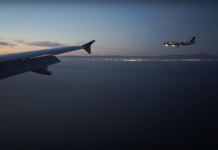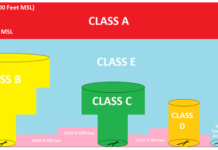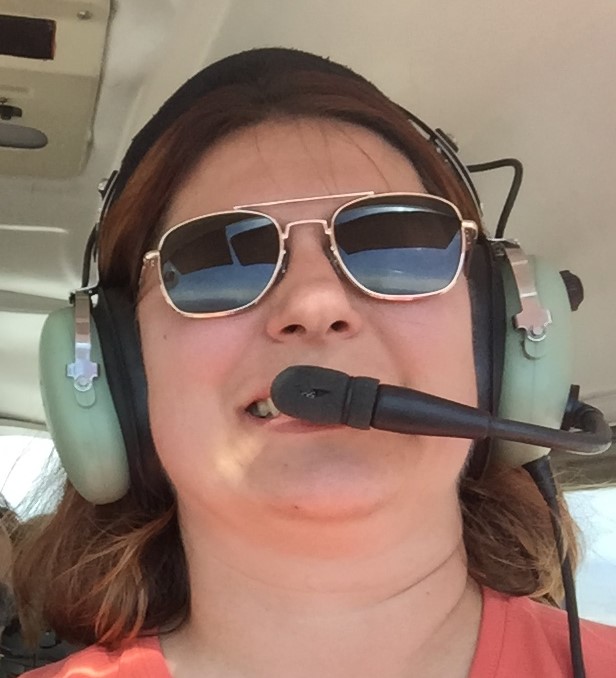If you’re anything like me, as a new private pilot, I only fly in “good” weather and when I want to. However, that alone severely limits my ability to get hours. Good weather for me is calm to about 10 kts winds, no hint of rain and at best, small cumulus clouds in the sky.
This, while slightly exaggerated, means that I only fly in “perfect” conditions. I have that flexibility as a private pilot who flies for fun. But if I want to expand my skill as a pilot there is more weather that I can fly in.
As a VFR pilot we need to know the rules and regulations out there. The FAA has established the minimum conditions a VFR pilot may fly.
14 CFR part 91.155
Thankfully the weather minimums reside in the Code of Federal Regulations (CFR) title 14 (Federal Aviation Administration) part 91.155. VFR or Visual Meteorological Conditions (VMC) are split up by airspace.
The table below shows the minimums as the regs state.
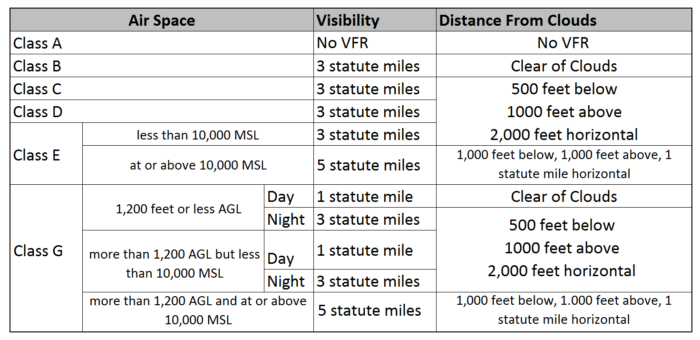
This is a lot of numbers and specifics to remember so let’s make it a little easier and break it down by airspace. Also, to help us remember the order of distance we will use ABH, or “Always Be Hunting” as in searching for clouds. That is Above, Below, Horizontal.
Class A
This is most likely the easiest to remember. No VFR in Class A airspace. Nadda, zip, zilch, none. While this may be easy to answer I promise you, if you are going for your interview with an airline they may try and trick you with this question. It’s not one to forget.
Remember: Class A, NO VFR.
Class B
This is our first airspace where we have minimums. They are both easy to remember, and very easy to fly. 3 statute miles and Clear of Clouds. The statute miles can be dropped (as all visibility numbers are statute miles) and Clear of Clouds is abbreviated to CoC.
What does clear of clouds mean? Simply don’t touch them. You can be darn close to them, but touching them breaks your minimums rule.
Remember: 3, CoC
Class C / Class D
Both of these classes can be easily remembered with a simple mnemonic. Almost everyone knows the Cessna 152. It is one of the most requested training airplanes the world over. And it will forever make history as a weather minimum mnemonic. 3 statue miles is shortened to 3 and clouds in the ABH format is 1,000 feet above, 500 feet below and 2,000 feet horizontal or 152.
Remember: 3, 152’s
Class E
This is the first class that has altitude requirements added to it. The altitudes are noted in MSL or Mean Sea Level or “True Altitude”. There are two specifications, below 10,000 feet MSL and at and above 10,000 feet MSL. Rather than remembering 9,999 feet or below it is easier to remember the 10,000 foot marker.
Since most small general aviation planes fly below 10,000 feet MSL for the most part the regs for Class E are the same as Class C/D. 3 statute miles and 1,000 feet above, 500 feet below and 2,000 feet horizontally.
Some of the faster, more advanced planes will fly above 10,000 feet MSL while not being on an IFR flight plan. For those planes the following are their minimums: 5 statute miles, 1,000 feet above, 1,000 feet below and 1 statue mile between.
Remember: BELOW 10,000 ft: 3, 152’s, 10,000 ft +: 5, 111
Class G
This is truly uncontrolled airspace. When you understand that, the minimums (and the corresponding altitudes) make sense. This is for your crop dusters, your powered gliders and the uncontrolled airports around the country.
It is the most complex airspace for weather minimums as it not only has 3 altitudes it also has day/night minimums. Our mnemonics are going to be very helpful here.
First, let’s start with the altitude. We mix and match AGL (Above ground level) and MSL (mean sea level) for this airspace. So pay great attention of the qualifier of the altitude.
1,200 feet AGL or less, broken up by day and night. Above 1,200 feet AGL but LESS THAN 10,000 ft MSL is also broken up by day and night. At or above 10,000 ft MSL is one classification.
Here is a handy drawing to help with the breakout of both day/night and the altitudes.

Remember:
1,2000 or below DAY: 1, CoC
1,2000 or below NIGHT: 3, 152’s
1,2000+ below 10,000 DAY: 1, 152
1,2000+ below 10,000 NIGHT: 3, 152’s
10,000 + 5, 111
Recap
Each progressively less controlled airspace has more and more restrictions. Unfortunatly, the task is on you to explicitly memorize each of these for your test. To help with that I’ve created a stripped down, mnemonic of each airspace and it’s corresponding vfr weather minimums.
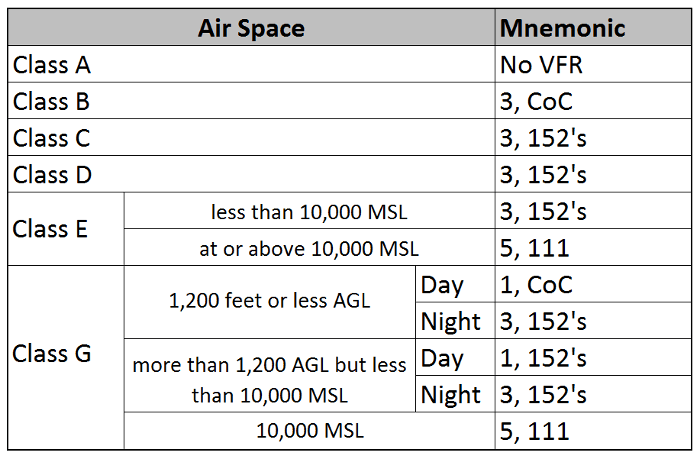
Actually, after looking at this I think we can make this easier:
- Class A – NO VFR
- Class B – 3, CoC
- Class C/D/E below 10K/G below 10K at night: 3, 152/s
- Class G 1,200 or less day: 1, CoC
- Class G 1,200+ below 10K day: 1, 152
- Class G/E 10K+: 5, 111
Special VFR
Since we’re talking weather and the FAA recognized minimums let’s take a moment and talk about special VFR. This is a condition that the FAA loves to test on during the private pilot exam. While I can’t guarantee that you will have a question pertaining to special VFR, I would prep for it.
If you find yourself in a pickle as the weather is closing in, but you can see the runway ahead of you, the special VFR may be the way to land. This is not something that a VFR pilot should rely on, however, it is useful to know about.
Requesting a special VFR clearance has the following restrictions:
- ATC clearance must be obtained before entering controlled airspace
- The VFR pilot MUST REQUEST A SPECIAL VFR. The controller cannot give it without the initial request from the pilot.
- 1 statute mile, clear of clouds
- Special VFR not permitted in some Class B airports.
I’m always one for safety, and if you need to invoke special VFR then do it, however, I believe that a flight is never worth your life. I also subscribe to the “just because you can, doesn’t mean you should” mantra.
Please use your best judgement before relying on the use of special VFR.
Test your knowledge
Now that you’ve seen the minimums, test your knowledge on a few general questions that may be on your private pilot test.
- What is the minimum weather conditions for airplanes operating under Special VFR conditions is Class D airspace?
- The basic VFR minimums for operating in Class B airspace are?
- What are the minimum weather requirements for airplanes operating in Class G airspace under 1,200 ft AGL?
Finding different test banks will give you a variety of questions that you may find on the written exam. The more prepared you are, the less this question will trip you up.
Conclusion
In conclusion, VFR clearances can be boiled down to 152’s, 111’s or CoC’s. Anything after that is a qualifier. The clearances need to be memorized. It’s not fun, but it needs to be done. Somethings are best committed to memory. However, this is one of those knowledge components that can turn ugly really quick if you are not aware of the legal minimums.
Hopefully I’ve given you a new way of looking at them with a decent explanation and memorization technique. As some pilot (probably a CFI) said at one point in time: “It’s better to be on the ground wishing you were in the air, than in the air wishing you were on the ground”.
I’d love to hear what you think. What did your CFI tell you to help remember the minimums? Do you know who originally said the quote? Leave me a comment and tell me all about it.
